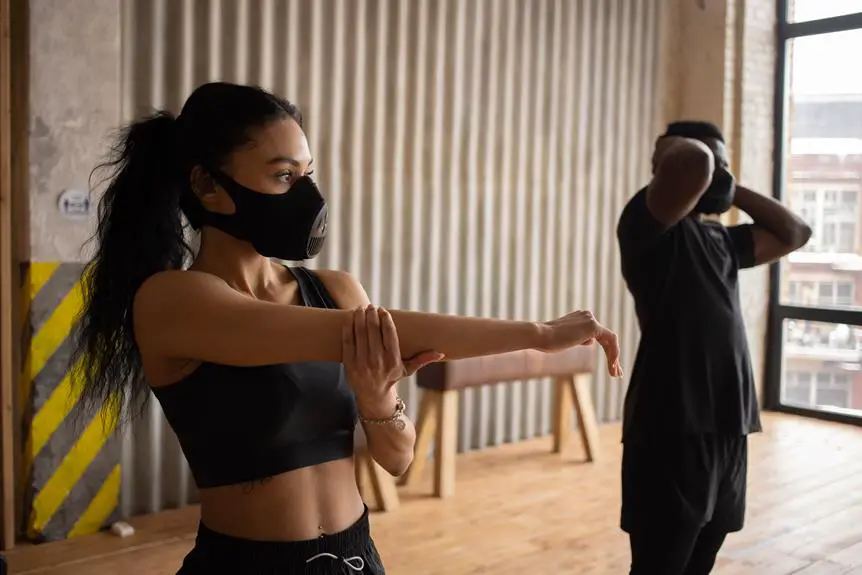Curious about elastane's stretch? This fabric, also known as spandex or Lycra, is a true chameleon in the world of textiles. Understand its composition, properties, and applications to master the art of working with elastane.
Whether you're a fashion enthusiast, a sewing aficionado, or simply someone interested in the science of fabrics, delving into the intricacies of elastane will broaden your understanding of this versatile material.
From its origins to its environmental impact, this introduction will guide you through all you need to know about elastane, leaving you equipped with the knowledge to make informed decisions when choosing and caring for elastane fabrics.
Key Takeaways
- Elastane, also known as spandex or Lycra, is a synthetic fiber known for its exceptional elasticity and strength.
- Elastane's stretch properties allow for ease of movement and a comfortable fit, making it ideal for sportswear and form-fitting garments.
- Proper care, such as washing in cold water and avoiding fabric softeners, helps preserve elastane's elasticity.
- The production of elastane has a negative environmental impact, contributing to air and water pollution, and there is a growing demand for sustainable alternatives and recycling initiatives.
The Origins of Elastane
You may not often consider the origins of elastane, but understanding its history can give you a deeper appreciation for this versatile fabric. Elastane, also known as spandex or Lycra, has a fascinating history. It was first developed in the late 1950s by chemists at DuPont, an American chemical company.
The production of elastane involves a complex chemical process, starting with the creation of a polymer solution that's then spun into fibers. These fibers are known for their exceptional elasticity and strength, making them an ideal choice for a wide range of clothing and other textile products.
Elastane quickly gained popularity in the textile industry due to its unique stretchiness and ability to enhance the comfort and fit of garments. Its introduction revolutionized the way clothing was designed and worn, leading to the creation of form-fitting and stretchable apparel that was previously unimaginable.
The innovation of elastane has had a lasting impact on fashion, sportswear, and everyday clothing, and its production continues to evolve with advancements in technology and sustainability. Understanding the history and production of elastane provides insight into its significance in the world of textiles and fashion.
Understanding Elastane's Stretchiness
Elastane's stretch properties are crucial to its performance in clothing, allowing for ease of movement and a comfortable fit.
Understanding fabric elasticity is key to appreciating how elastane enhances the flexibility and stretchiness of garments.
Additionally, the mechanisms behind stretch recovery play a significant role in maintaining the shape and structure of elastane-containing fabrics over time.
Elastane's Stretch Properties
Understanding elastane's stretchiness enhances your ability to select the most suitable fabric for your needs. Elastane is widely used in various applications, such as sportswear, swimwear, and form-fitting garments, due to its exceptional stretch properties. When considering elastane fabric applications, it's important to understand that the stretch in elastane allows for greater flexibility and comfort in clothing.
Additionally, knowing elastane fabric care tips is crucial for maintaining the stretch properties. To preserve its elasticity, it's recommended to wash elastane garments in cold water and avoid using fabric softeners. Furthermore, air drying or using a low-heat setting when machine drying can help prevent the elastane fibers from breaking down.
Fabric Elasticity Explained
Fabric elasticity enhances the comfort and flexibility of clothing items made with elastane. Understanding the stretchiness of elastane is crucial in appreciating its benefits. Here's what you need to know:
- Enhanced Comfort: Fabric elasticity ensures that clothing items made with elastane move with your body, providing a comfortable and unrestricted feel.
- Improved Flexibility: The stretchiness of elastane allows for greater freedom of movement, making the clothing items more versatile for various activities.
- Stretch Fabric Innovations: Innovations in stretch fabric technology have led to the creation of highly elastic materials that retain their shape and provide exceptional comfort and support.
Understanding the elasticity benefits and stretch fabric innovations is essential for appreciating the significance of elastane in modern clothing.
Stretch Recovery Mechanisms
When wearing clothing made with elastane, you may notice that the fabric stretches and then returns to its original shape. This unique characteristic is due to elastane's stretch recovery mechanisms, which play a crucial role in understanding the fabric's elasticity and garment performance. The stretch recovery of elastane is essential for maintaining fabric durability and ensuring that clothing retains its shape over time. Understanding how elastane fibers recover after stretching is vital for assessing garment performance and longevity.
| Stretch Recovery Mechanisms | Description |
|---|---|
| Elastic Deformation | Stretching of elastane fibers under tension |
| Recoil | Return of elastane fibers to their original shape |
| Fabric Durability | Ability of elastane to maintain its stretch recovery properties |
Elastane's stretch recovery mechanisms contribute significantly to the fabric's overall performance and durability, making it a valuable component in modern clothing.
Properties and Composition of Elastane
To understand the properties and composition of elastane, you can examine its chemical structure and unique stretch capabilities.
Elastane, also known as spandex or Lycra, is a synthetic fiber composed of segmented polyurethane. This composition grants elastane its exceptional elasticity and stretch recovery properties, making it an essential component in various fabric blends.
The properties of elastane contribute significantly to fabric durability, as it can withstand repeated stretching and recover its original shape, providing long-lasting comfort and fit.
When incorporated into fabric construction, elastane enhances flexibility, resilience, and form-fitting attributes, making it a popular choice in sportswear, swimwear, and form-fitting apparel.
Understanding the intricate composition and properties of elastane is crucial for fabric development and garment performance, allowing designers and manufacturers to create comfortable and durable clothing that meets the demands of modern active lifestyles.
Applications of Elastane in Fashion
Elastane, also known as spandex or Lycra, is a versatile stretch fabric that's widely used in fashion. Its ability to stretch and recover makes it an ideal choice for garments that require flexibility and comfort, such as activewear, swimwear, and form-fitting clothing.
Elastane enhances the overall fit and performance of clothing, providing a snug yet comfortable feel for the wearer.
Versatile Stretch Fabric
If you're looking for a fabric that offers comfort, flexibility, and a sleek look, elastane is a go-to choice for various applications in fashion.
This versatile stretch fabric has numerous benefits, making it a popular choice in the fashion industry. It's extensively used in sportswear due to its ability to provide unrestricted movement and support during physical activities.
Additionally, elastane is commonly incorporated into everyday clothing, such as jeans and dresses, to offer a flattering and comfortable fit. The fabric's stretch properties also make it an ideal choice for creating form-fitting garments that accentuate the body's natural curves.
Whether you're hitting the gym or simply looking for stylish and comfortable attire, elastane-infused clothing is a go-to option for a wide range of fashion applications.
Enhances Garment Comfort
When considering garment comfort, elastane enhances the overall wearability and flexibility of clothing, making it a desirable choice for a wide range of fashion applications.
Garment flexibility is significantly improved with the addition of elastane, allowing for better movement and fit. This is particularly beneficial in activewear, denim, and tailored garments, where a balance between comfort and structure is essential.
Elastane also contributes to fabric breathability, ensuring that the clothing maintains a comfortable temperature and doesn't restrict airflow.
The ability of elastane to enhance the comfort of garments has made it a popular choice in the fashion industry, as it allows for the creation of clothing that not only looks stylish but also feels great to wear.
Maintaining and Caring for Elastane Fabrics
To maintain and care for elastane fabrics, you should always check the care label for specific washing instructions. Proper maintenance and washing of elastane fabrics are essential for ensuring their durability and longevity. Here are some key tips to help you care for your elastane garments:
- Gentle Washing: When washing elastane fabrics, opt for a gentle cycle with cold water to prevent damage to the fibers. Using a mild detergent can also help maintain the fabric's elasticity.
- Avoid Heat: It's important to avoid high heat when caring for elastane fabrics. Heat can cause the fibers to break down and lose their stretchiness. Therefore, air drying or using a low-heat setting in the dryer is recommended.
- Storage: Proper storage is key to preserving elastane fabrics. Avoid hanging elastane garments in direct sunlight for extended periods, as this can cause the fabric to degrade over time.
Following these care tips can help you maintain the quality and comfort of your elastane garments, ensuring that they remain in top condition for an extended period.
The Environmental Impact of Elastane
Elastane has an environmental impact, which is often overlooked by consumers when purchasing clothing items. The production of elastane involves the use of non-renewable resources and the release of harmful chemicals into the environment. The manufacturing process of elastane, also known as spandex or Lycra, contributes to air and water pollution, as well as the emission of greenhouse gases. Additionally, the disposal of garments containing elastane poses a significant environmental challenge, as the fabric isn't biodegradable and can take hundreds of years to decompose in landfills.
As consumers become more conscious of the environmental impact of their fashion choices, there's a growing demand for sustainable alternatives to elastane. Some brands are now incorporating recycled elastane into their clothing lines, reducing the need for new raw materials and diverting waste from landfills. Furthermore, innovative companies are exploring natural and biodegradable alternatives to elastane, such as plant-based fibers and materials derived from renewable sources.
Tips for Working With Elastane in Sewing
When working with elastane in sewing, you should use a ballpoint needle to prevent snags and maintain the fabric's stretch.
Additionally, here are some tips to help you work effectively with elastane:
- Seam construction: Opt for a narrow zigzag stitch or a stretch stitch on your sewing machine to allow the seams to stretch without breaking.
- Handling the fabric: When cutting elastane, ensure the fabric is laid flat and use pattern weights instead of pins to prevent distortion.
- Fabric durability: To enhance the durability of elastane garments, consider reinforcing high-stress areas such as necklines, armholes, and hems with clear elastic or stabilizing tape.
When working with elastane, mastering these sewing techniques will ensure that your finished garment not only maintains its stretch but also retains its fabric durability.
Frequently Asked Questions
Can Elastane Fabrics Be Used for Outdoor and Athletic Wear?
Elastane fabrics are suitable for outdoor and athletic wear due to their stretchiness, which provides flexibility and comfort during physical activities. Their breathability and durability offer benefits, but potential drawbacks include reduced insulation and moisture retention.
Are There Any Potential Health Concerns Associated With Wearing Elastane Fabrics?
When wearing elastane fabrics, potential allergies and skin irritation can occur, particularly for those with sensitive skin. However, the fabric's breathability and moisture-wicking properties make it suitable for athletic and outdoor wear.
What Are the Best Practices for Storing Elastane Clothing to Maintain Its Stretchiness?
To maintain elastane clothing's stretchiness, store it flat or hung up to prevent stretching out. Wash in cold water and avoid fabric softeners. Air dry or use low heat in the dryer to preserve elasticity.
Can Elastane Fabrics Be Easily Dyed or Printed On?
Yes, elastane fabrics can be easily dyed or printed on. Fabric printing requires proper textile pigments, and dyeing demands color fastness. It's essential to follow proper dyeing and printing techniques to ensure desired results.
Are There Any Specific Challenges or Tips for Sewing With Elastane Fabrics, Such as Avoiding Puckering or Stretching?
When sewing with elastane, challenges may arise such as avoiding puckering and stretching. To overcome these, use a ballpoint needle and a walking foot, and stabilize seams with clear elastic. Remember to handle and launder the fabric with care.
- How Does Ring Spun Cotton Affect Garment Fit and Shape Retention? - August 13, 2024
- What Are the Challenges in Producing Ring Spun Cotton? - August 13, 2024
- Is Ring Spun Cotton Suitable for Plus-Size Clothing? - August 13, 2024







